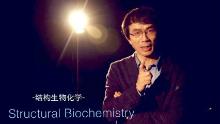暂无课程咨询信息 [发表课程咨询]
结构生物化学 南京大学
- 内容简介:
-
Hi!我是南京大学的杨荣武教授。我们可以在不同的水平上去研究生命,但最有挑战性的是分子水平,而生物化学恰恰就是这么一门学科。
你知道DNA为什么最适合充当生物的遗传物质但却无法催化反应?为什么硝化甘油这种炸药可治疗心脏病?甲醇中毒如何解毒?
想知道这些问题的答案就跟我一起学习生化吧!
- 价格:
- 免费
课程介绍
| 第一章 蛋白质的结构与功能(Chapter 1 Structure and Function of Proteins) | 1.1 氨基酸(1.1 Amino acids) | 1.1 氨基酸(1.1 Amino acids) |
| 第一章 蛋白质的结构与功能(Chapter 1 Structure and Function of Proteins) | 1.2 蛋白质氨基酸与非蛋白质氨基酸(1.2 Proteinogenic AA & non-protenogenic AA) | 1.2 蛋白质氨基酸与非蛋白质氨基酸 |
| 第一章 蛋白质的结构与功能(Chapter 1 Structure and Function of Proteins) | 1.3 疏水氨基酸与亲水氨基酸(1.3 Hydrophobic & Hydrophilic AAs) | 1.3 疏水氨基酸与亲水氨基酸 |
| 第一章 蛋白质的结构与功能(Chapter 1 Structure and Function of Proteins) | 1.4 必需氨基酸与非必需氨基酸(1.4 Essential & Non-essential AAs) | 1.4 必需氨基酸与非必需氨基酸 |
| 第一章 蛋白质的结构与功能(Chapter 1 Structure and Function of Proteins) | 1.5 氨基酸的英文缩写(1.5 Abbreviations for 22 amino acids) | 1.5 氨基酸的英文缩写 |
| 第一章 蛋白质的结构与功能(Chapter 1 Structure and Function of Proteins) | 1.6 氨基酸的缩合反应(1.6 AA Condensation reaction) | 1.6 氨基酸的缩合反应 |
| 第一章 蛋白质的结构与功能(Chapter 1 Structure and Function of Proteins) | 1.7 氨基酸的手性(1.7 Chirality of Amino Acids) | 1.7 氨基酸的手性 |
| 第一章 蛋白质的结构与功能(Chapter 1 Structure and Function of Proteins) | 1.8 氨基酸的两性解离与等电点(1.8 Acid & base dissociation of amino acids and pI) | 1.8 氨基酸的两性解离与等电点 |
| 第一章 蛋白质的结构与功能(Chapter 1 Structure and Function of Proteins) | 1.9 茚三酮反应(1.9 Reaction with Ninhydrin) | 1.9 茚三酮反应 |
| 第一章 蛋白质的结构与功能(Chapter 1 Structure and Function of Proteins) | 1. 10 Sanger反应(1.10 Reaction with DNFB) | 1. 10 Sanger反应 |
| 第一章 蛋白质的结构与功能(Chapter 1 Structure and Function of Proteins) | 1.11 Edman反应(1.11 Reaction with PITC) | 1.11 Edman反应 |
| 第一章 蛋白质的结构与功能(Chapter 1 Structure and Function of Proteins) | 1.12 蛋白质(1.12 Proteins) | 1.12 蛋白质 |
| 第一章 蛋白质的结构与功能(Chapter 1 Structure and Function of Proteins) | 1.13 蛋白质的一级结构(1.13 Primary Structure of Proteins) | 1.13 蛋白质的一级结构 |
| 第一章 蛋白质的结构与功能(Chapter 1 Structure and Function of Proteins) | 1.14 肽键(1.14 Peptide bonds) | 1.14 肽键 |
| 第一章 蛋白质的结构与功能(Chapter 1 Structure and Function of Proteins) | 1.15 蛋白质的二级结构(1.15 Secondary Structure of Proteins) | 1.15 蛋白质的二级结构 |
| 第一章 蛋白质的结构与功能(Chapter 1 Structure and Function of Proteins) | 1.16 α螺旋(1.16 The Alpha Helix) | 1.16 α螺旋 |
| 第一章 蛋白质的结构与功能(Chapter 1 Structure and Function of Proteins) | 1.17 β折叠(1.17 The Beta-Pleated Sheet) | 1.17 β折叠 |
| 第一章 蛋白质的结构与功能(Chapter 1 Structure and Function of Proteins) | 1.18 β转角(1.18 The Beta Turn) | 1.18 β转角 |
| 第一章 蛋白质的结构与功能(Chapter 1 Structure and Function of Proteins) | 1.19 β突起(1.19 The Beta Bulge) | 1.19 β突起 |
| 第一章 蛋白质的结构与功能(Chapter 1 Structure and Function of Proteins) | 1.20 蛋白质的三级结构(1.20 Tertiary Structure of Proteins) | 1.20 蛋白质的三级结构 |
| 第一章 蛋白质的结构与功能(Chapter 1 Structure and Function of Proteins) | 1. 21 疏水键(1.21 Hydrophobic interactions) | 1. 21 疏水键 |
| 第一章 蛋白质的结构与功能(Chapter 1 Structure and Function of Proteins) | 1.22 模体(1.22 Motif) | 1.22 模体 |
| 第一章 蛋白质的结构与功能(Chapter 1 Structure and Function of Proteins) | 1.23 结构域(1.23 Domain) | 1.23 结构域 |
| 第一章 蛋白质的结构与功能(Chapter 1 Structure and Function of Proteins) | 1.24 蛋白质的四级结构(1.24 Quaternary Structure of Proteins) | 1.24 蛋白质的四级结构 |
| 第一章 蛋白质的结构与功能(Chapter 1 Structure and Function of Proteins) | 1.25 蛋白质的折叠(1.25 Protein folding) | 1.25 蛋白质的折叠 |
| 第一章 蛋白质的结构与功能(Chapter 1 Structure and Function of Proteins) | 1.26 天然无折叠蛋白(1.26 Natively Unfolded Proteins) | 1.26 天然无折叠蛋白 |
| 第一章 蛋白质的结构与功能(Chapter 1 Structure and Function of Proteins) | 1.27 Anfinsen实验(1.27 Anfinsen’s Experiment) | 1.27 Anfinsen实验 |
| 第一章 蛋白质的结构与功能(Chapter 1 Structure and Function of Proteins) | 1.28 分子伴侣(1.28 Molecular Chaperone) | 1.28 分子伴侣 |
| 第一章 蛋白质的结构与功能(Chapter 1 Structure and Function of Proteins) | 1.29 蛋白质二硫化物异构酶(1.29 Protein disulfide isomerase) | 1.29 蛋白质二硫化物异构酶 |
| 第一章 蛋白质的结构与功能(Chapter 1 Structure and Function of Proteins) | 1.30 脯氨酰肽酰顺反异构酶(1.30 Peptidylprolyl cis-trans isomerase) | 1.30 脯氨酰肽酰顺反异构酶 |
| 第一章 蛋白质的结构与功能(Chapter 1 Structure and Function of Proteins) | 1.31 朊病毒(1.31 Prions) | 1.31 朊病毒 |
| 第一章 蛋白质的结构与功能(Chapter 1 Structure and Function of Proteins) | 1.32 蛋白质组(1.32 Proteome) | 1.32 蛋白质组 |
| 第一章 蛋白质的结构与功能(Chapter 1 Structure and Function of Proteins) | 1.33 蛋白质的功能(1.33 Functions of Proteins) | 1.33 蛋白质的功能 |
| 第一章 蛋白质的结构与功能(Chapter 1 Structure and Function of Proteins) | 1.34 兼职蛋白(1.34 Moonlighting Proteins) | 1.34 兼职蛋白 |
| 第一章 蛋白质的结构与功能(Chapter 1 Structure and Function of Proteins) | 1.35 蛋白质结构与功能之间的关系(1.35 Structure and function relationships of proteins) | 1.35 蛋白质结构与功能之间的关系 |
| 第一章 蛋白质的结构与功能(Chapter 1 Structure and Function of Proteins) | 1.36. α角蛋白(1.36 Alpha Keratin) | 1.36. α角蛋白 |
| 第一章 蛋白质的结构与功能(Chapter 1 Structure and Function of Proteins) | 1.37 β角蛋白(1.37 Beta Keratin) | 1.37 β角蛋白 |
| 第一章 蛋白质的结构与功能(Chapter 1 Structure and Function of Proteins) | 1.38 胶原蛋白(1.38 Collagen) | 1.38 胶原蛋白 |
| 第一章 蛋白质的结构与功能(Chapter 1 Structure and Function of Proteins) | 1.39 肌红蛋白与血红蛋白(1.39 Myoglobin & Hemoglobin) | 1.39 肌红蛋白与血红蛋白 |
| 第一章 蛋白质的结构与功能(Chapter 1 Structure and Function of Proteins) | 1.40 正协同效应(1.40 Positive Cooperativity) | 1.40 正协同效应(1.40 Positive Cooperativity) |
| 第一章 蛋白质的结构与功能(Chapter 1 Structure and Function of Proteins) | 1.41 波尔效应(1.41 Bohr Effect) | 1.41 波尔效应 |
| 第一章 蛋白质的结构与功能(Chapter 1 Structure and Function of Proteins) | 1.42 别构效应(1.42 Allosteric effect) | 1.42 别构效应 |
| 第一章 蛋白质的结构与功能(Chapter 1 Structure and Function of Proteins) | 1.43 HbS | 1.43 HbS |
| 第一章 蛋白质的结构与功能(Chapter 1 Structure and Function of Proteins) | 1.44 HbF | 1.44 HbF |
| 第二章 核酸的结构与功能(Chapter 2 Structure and Function of Nucleic Acids) | 2.1 碱基(2.1 Bases) | 2.1 碱基 |
| 第二章 核酸的结构与功能(Chapter 2 Structure and Function of Nucleic Acids) | 2.2 互变异构(2.2 Keto-enol tautomerism) | 2.2 互变异构 |
| 第二章 核酸的结构与功能(Chapter 2 Structure and Function of Nucleic Acids) | 2.3 核苷(2.3 Nucleosides) | 2.3 核苷 |
| 第二章 核酸的结构与功能(Chapter 2 Structure and Function of Nucleic Acids) | 2.4 核苷酸(2.4 Nucleotides) | 2.4 核苷酸 |
| 第二章 核酸的结构与功能(Chapter 2 Structure and Function of Nucleic Acids) | 2.5 核酸(2.5 Nucleic Acids) | 2.5 核酸 |
| 第二章 核酸的结构与功能(Chapter 2 Structure and Function of Nucleic Acids) | 2.6 多种多样的RNA(2.6 Versatile RNAs) | 2.6 多种多样的RNA |
| 第二章 核酸的结构与功能(Chapter 2 Structure and Function of Nucleic Acids) | 2.7 核酸的一级结构(2.7 Primary Structure of Nucleic Acids) | 2.7 核酸的一级结构 |
| 第二章 核酸的结构与功能(Chapter 2 Structure and Function of Nucleic Acids) | 2.8 B-DNA | 2.8 B-DNA |
| 第二章 核酸的结构与功能(Chapter 2 Structure and Function of Nucleic Acids) | 2.9 A-DNA | 2.9 A-DNA |
| 第二章 核酸的结构与功能(Chapter 2 Structure and Function of Nucleic Acids) | 2.10 Z-DNA | 2.10 Z-DNA |
| 第二章 核酸的结构与功能(Chapter 2 Structure and Function of Nucleic Acids) | 2.11 几种DNA的非常规的二级结构(2.11 Other forms of secondary structure of DNA) | 2.11 几种DNA的非常规的二级结构 |
| 第二章 核酸的结构与功能(Chapter 2 Structure and Function of Nucleic Acids) | 2.12 RNA二级结构(2.12 Secondary Structure of RNA) | 2.12 RNA二级结构 |
| 第二章 核酸的结构与功能(Chapter 2 Structure and Function of Nucleic Acids) | 2.13 DNA三级结构(2.13 Tertiary Structure of DNA) | 2.13 DNA三级结构 |
| 第二章 核酸的结构与功能(Chapter 2 Structure and Function of Nucleic Acids) | 2.14 RNA三级结构(2.14 Tertiary Structure of RNA) | 2.14 RNA三级结构 |
| 第二章 核酸的结构与功能(Chapter 2 Structure and Function of Nucleic Acids) | 2.15 核糖核酸蛋白复合物(2.15 RNA-Protein Complex) | 2.15 核糖核酸蛋白复合物 |
| 第二章 核酸的结构与功能(Chapter 2 Structure and Function of Nucleic Acids) | 2.16 核小体(2.16 Nucleosome) | 2.16 核小体 |
| 第二章 核酸的结构与功能(Chapter 2 Structure and Function of Nucleic Acids) | 2.17 RNA世界(2.17 The RNA world hypothesis) | 2.17 RNA世界 |
| 第三章 蛋白质和核酸的性质(Chapter 3 Properties of Proteins and Nucleic Acids) | 3.1 紫外吸收(3.1 UV absorption) | 3.1 紫外吸收 |
| 第三章 蛋白质和核酸的性质(Chapter 3 Properties of Proteins and Nucleic Acids) | 3.2 沉淀(3.2 Precipitation) | 3.2 沉淀 |
| 第三章 蛋白质和核酸的性质(Chapter 3 Properties of Proteins and Nucleic Acids) | 3.3 两性解离(3.3 Acid & base dissociation and pI) | 3.3 两性解离 |
| 第三章 蛋白质和核酸的性质(Chapter 3 Properties of Proteins and Nucleic Acids) | 3.4 变性(3.4 Denaturation) | 3.4 变性 |
| 第三章 蛋白质和核酸的性质(Chapter 3 Properties of Proteins and Nucleic Acids) | 3.5 复性(3.5 Renaturation) | 3.5 复性 |
| 第三章 蛋白质和核酸的性质(Chapter 3 Properties of Proteins and Nucleic Acids) | 3.6 Tm | 3.6 Tm |
| 第三章 蛋白质和核酸的性质(Chapter 3 Properties of Proteins and Nucleic Acids) | 3.7 水解(3.7 Hydrolysis) | 3.7 水解 |
| 第三章 蛋白质和核酸的性质(Chapter 3 Properties of Proteins and Nucleic Acids) | 3.8 蛋白质的颜色反应(3.8 Protein coloring reaction) | 3.8 蛋白质的颜色反应 |
| 第三章 蛋白质和核酸的性质(Chapter 3 Properties of Proteins and Nucleic Acids) | 3.9 电泳(3.9 Electrophoresis) | 3.9 电泳 |
| 第三章 蛋白质和核酸的性质(Chapter 3 Properties of Proteins and Nucleic Acids) | 3.10 层析(3.10 Chromatography) | 3.10 层析 |
| 第三章 蛋白质和核酸的性质(Chapter 3 Properties of Proteins and Nucleic Acids) | 3.11 透析与超滤(3.11 Dialysis and Ultrafiltration) | 3.11 透析与超滤 |
| 第四章 酶的结构与功能(Chapter 4 Structure and Function of Enzymes) | 4.1 酶(4.1 Enzymes) | 4.1 酶 |
| 第四章 酶的结构与功能(Chapter 4 Structure and Function of Enzymes) | 4.2 辅助因子(4.2 Cofactors) | 4.2 辅助因子 |
| 第四章 酶的结构与功能(Chapter 4 Structure and Function of Enzymes) | 4.3 核酶(4.3 Ribozymes) | 4.3 核酶 |
| 第四章 酶的结构与功能(Chapter 4 Structure and Function of Enzymes) | 4.4 活性中心(4.4 The Active Site) | 4.4 活性中心 |
| 第四章 酶的结构与功能(Chapter 4 Structure and Function of Enzymes) | 4.5 “锁与钥匙”模型(4.5 The Lock and Key Model) | 4.5 “锁与钥匙”模型 |
| 第四章 酶的结构与功能(Chapter 4 Structure and Function of Enzymes) | 4.6 “诱导契合”模型(4.6 The Induced Fit Model) | 4.6 “诱导契合”模型 |
| 第四章 酶的结构与功能(Chapter 4 Structure and Function of Enzymes) | 4.7 “三点附着”模型(4.7 The Three-point Attachment Model) | 4.7 “三点附着”模型 |
| 第四章 酶的结构与功能(Chapter 4 Structure and Function of Enzymes) | 4.8 酶的命名和分类(4.8 Enzyme Nomenclature) | 4.8 酶的命名和分类 |
| 第四章 酶的结构与功能(Chapter 4 Structure and Function of Enzymes) | 4.9 酶动力学(4.9 Enzyme Kinetics) | 4.9 酶动力学 |
| 第四章 酶的结构与功能(Chapter 4 Structure and Function of Enzymes) | 4.10 米氏方程(4.10 The Mechaelis-Menten Equation) | 4.10 米氏方程 |
| 第四章 酶的结构与功能(Chapter 4 Structure and Function of Enzymes) | 4.11 kcat和kcat/Km(4.11 kcat & kcat/Km) | 4.11 kcat和kcat/Km |
| 第四章 酶的结构与功能(Chapter 4 Structure and Function of Enzymes) | 4.12 双倒数作图(4.12 The Double-Reciprocal Plot) | 4.12 双倒数作图 |
| 第四章 酶的结构与功能(Chapter 4 Structure and Function of Enzymes) | 4.13 酶抑制剂(4.13 Enzyme Inhibitors) | 4.13 酶抑制剂 |
| 第四章 酶的结构与功能(Chapter 4 Structure and Function of Enzymes) | 4.14竞争性抑制剂(4.14 Competitive Inhibitor) | 4.14竞争性抑制剂 |
| 第四章 酶的结构与功能(Chapter 4 Structure and Function of Enzymes) | 4.15 非竞争性抑制剂(4.15 Non-competitive Inhibitor) | 4.15 非竞争性抑制剂 |
| 第四章 酶的结构与功能(Chapter 4 Structure and Function of Enzymes) | 4.16 反竞争性抑制剂(4.16 Uncompetitive Inhibitor) | 4.16 反竞争性抑制剂 |
| 第四章 酶的结构与功能(Chapter 4 Structure and Function of Enzymes) | 4.17 基团特异性抑制剂(4.17 Group Specific Reagent) | 4.17 基团特异性抑制剂 |
| 第四章 酶的结构与功能(Chapter 4 Structure and Function of Enzymes) | 4.18 底物类似物(4.18 Substrate Analogue) | 4.18 底物类似物 |
| 第四章 酶的结构与功能(Chapter 4 Structure and Function of Enzymes) | 4.19 自杀性抑制剂(4.19 Suicide Inhibitor) | 4.19 自杀性抑制剂 |
| 第四章 酶的结构与功能(Chapter 4 Structure and Function of Enzymes) | 4.20 别构酶(4.20 Allosteric Enzymes) | 4.20 别构酶 |
| 第四章 酶的结构与功能(Chapter 4 Structure and Function of Enzymes) | 4.21 齐变模型(4.21 The Concerted Model) | 4.21 齐变模型 |
| 第四章 酶的结构与功能(Chapter 4 Structure and Function of Enzymes) | 4.22 序变模型(4.22 The Sequential Model) | 4.22 序变模型 |
| 第四章 酶的结构与功能(Chapter 4 Structure and Function of Enzymes) | 4.23 过渡态稳定学说(4.23 The Transition-State Stabilization Theory) | 4.23 过渡态稳定学说 |
| 第四章 酶的结构与功能(Chapter 4 Structure and Function of Enzymes) | 4.24 抗体酶(4.24 Abzymes) | 4.24 抗体酶 |
| 第四章 酶的结构与功能(Chapter 4 Structure and Function of Enzymes) | 4.25 临近与定向效应(4.25 Catalysis by Proximity and Orientation) | 4.25 临近与定向效应 |
| 第四章 酶的结构与功能(Chapter 4 Structure and Function of Enzymes) | 4.26 广义酸碱催化(4.26 General Acid-Base Catalysis) | 4.26 广义酸碱催化 |
| 第四章 酶的结构与功能(Chapter 4 Structure and Function of Enzymes) | 4.27 静电催化(Electrostatic Catalysis) | 4.27 静电催化 |
| 第四章 酶的结构与功能(Chapter 4 Structure and Function of Enzymes) | 4.28 金属催化(4.28 Metal Catalysis) | 4.28 金属催化 |
| 第四章 酶的结构与功能(Chapter 4 Structure and Function of Enzymes) | 4.29 共价催化(4.29 Covalent Catalysis) | 4.29 共价催化 |
| 第四章 酶的结构与功能(Chapter 4 Structure and Function of Enzymes) | 4.30 底物形变(4.30 Substrate Strain) | 4.30 底物形变 |
| 第四章 酶的结构与功能(Chapter 4 Structure and Function of Enzymes) | 4.31 蛋白酶(4.31 Proteases) | 4.31 蛋白酶 |
| 第四章 酶的结构与功能(Chapter 4 Structure and Function of Enzymes) | 4.32 酶活性的调节(4.32 Regulation of Enzyme Activities) | 4.32 酶活性的调节 |
| 第四章 酶的结构与功能(Chapter 4 Structure and Function of Enzymes) | 4.33 同工酶(4.33 Isozymes) | 4.33 同工酶 |
| 第四章 酶的结构与功能(Chapter 4 Structure and Function of Enzymes) | 4.34 别构调节(4.34 Allosteric Control) | 4.34 别构调节 |
| 第四章 酶的结构与功能(Chapter 4 Structure and Function of Enzymes) | 4.35 共价修饰调节(4.35 Regulation by Covalent Modification) | 4.35 共价修饰调节 |
| 第四章 酶的结构与功能(Chapter 4 Structure and Function of Enzymes) | 4.36 水解激活(4.36 Proteolytic Activation) | 4.36 水解激活 |
| 第四章 酶的结构与功能(Chapter 4 Structure and Function of Enzymes) | 4.37 调节蛋白的激活和抑制(4.37 Stimulation and Inhibition by Control Proteins) | 4.37 调节蛋白的激活和抑制 |
| 第四章 酶的结构与功能(Chapter 4 Structure and Function of Enzymes) | 4.38 维生素(4.38 Vitamins) | 4.38 维生素 |
| 第五章 糖类和脂类的结构与功能(Chapter 5 Structure and Function of Carbohydrates and Lipids) | 5.1 碳水化合物(5.1 Carbohydrates) | 5.1 碳水化合物 |
| 第五章 糖类和脂类的结构与功能(Chapter 5 Structure and Function of Carbohydrates and Lipids) | 5.2 单糖(5.2 Monosaccharides) | 5.2 单糖 |
| 第五章 糖类和脂类的结构与功能(Chapter 5 Structure and Function of Carbohydrates and Lipids) | 5.3 差向异构体(5.3 Epimers) | 5.3 差向异构体 |
| 第五章 糖类和脂类的结构与功能(Chapter 5 Structure and Function of Carbohydrates and Lipids) | 5.4 异头体(5.4 Anomer) | 5.4 异头体 |
| 第五章 糖类和脂类的结构与功能(Chapter 5 Structure and Function of Carbohydrates and Lipids) | 5.5 寡糖(5.5 Oligosaccharides) | 5.5 寡糖 |
| 第五章 糖类和脂类的结构与功能(Chapter 5 Structure and Function of Carbohydrates and Lipids) | 5.6 多糖(5.6 Polysaccharides) | 5.6 多糖 |
| 第五章 糖类和脂类的结构与功能(Chapter 5 Structure and Function of Carbohydrates and Lipids) | 5.7 糖缀化合物(5.7 Glycoconjugates) | 5.7 糖缀化合物 |
| 第五章 糖类和脂类的结构与功能(Chapter 5 Structure and Function of Carbohydrates and Lipids) | 5.8 脂类(5.8 Lipids) | 5.8 脂类 |
| 第五章 糖类和脂类的结构与功能(Chapter 5 Structure and Function of Carbohydrates and Lipids) | 5.9 脂肪酸(5.9 Fatty acids) | 5.9 脂肪酸 |
| 第五章 糖类和脂类的结构与功能(Chapter 5 Structure and Function of Carbohydrates and Lipids) | 5.10 脂肪(5.10 Fats) | 5.10 脂肪 |
| 第五章 糖类和脂类的结构与功能(Chapter 5 Structure and Function of Carbohydrates and Lipids) | 5.11 反式脂肪(5.11 Trans Fats) | 5.11 反式脂肪 |
| 第五章 糖类和脂类的结构与功能(Chapter 5 Structure and Function of Carbohydrates and Lipids) | 5.12 磷脂(5.12 Phospholipids) | 5.12 磷脂 |
| 第五章 糖类和脂类的结构与功能(Chapter 5 Structure and Function of Carbohydrates and Lipids) | 5.13 胆固醇(5.13 Cholesterol) | 5.13 胆固醇 |
| 第五章 糖类和脂类的结构与功能(Chapter 5 Structure and Function of Carbohydrates and Lipids) | 5.14 脂双层(5.14 Lipid Bilayers) | 5.14 脂双层 |
| 第六章 激素的结构与功能(Chapter 6 Structure and Function of Hormones) | 6.1 激素(6.1 Hormones) | 6.1 激素 |
| 第六章 激素的结构与功能(Chapter 6 Structure and Function of Hormones) | 6.2 放射免疫测定法(6.2 Radioimmunoassay,RIA) | 6.2 放射免疫测定法 |
| 第六章 激素的结构与功能(Chapter 6 Structure and Function of Hormones) | 6.3 受体(6.3 Receptors) | 6.3 受体 |
| 第六章 激素的结构与功能(Chapter 6 Structure and Function of Hormones) | 6.4 第二信使(6.4 Second Messengers) | 6.4 第二信使 |
| 第六章 激素的结构与功能(Chapter 6 Structure and Function of Hormones) | 6.5 G蛋白(6.5 G-proteins) | 6.5 G蛋白 |
| 第六章 激素的结构与功能(Chapter 6 Structure and Function of Hormones) | 6.6 蛋白质激酶(6.6 Protein Kinases) | 6.6 蛋白质激酶 |
| 第六章 激素的结构与功能(Chapter 6 Structure and Function of Hormones) | 6.7 通过胞内受体的激素作用机制(6.7 Mechanism of Hormone Action by Intracellular Receptors) | 6.7 通过胞内受体的激素作用机制 |
| 第六章 激素的结构与功能(Chapter 6 Structure and Function of Hormones) | 6.8 PKA系统(6.8 The PKA System) | 6.8 PKA系统 |
| 第六章 激素的结构与功能(Chapter 6 Structure and Function of Hormones) | 6.9 PKC系统(6.9 The PKC System) | 6.9 PKC系统 |
| 第六章 激素的结构与功能(Chapter 6 Structure and Function of Hormones) | 6.10 PKG系统(6.10 The PKG System) | 6.10 PKG系统 |
| 第六章 激素的结构与功能(Chapter 6 Structure and Function of Hormones) | 6.11 NO系统(6.11 Nitric Oxide System) | 6.11 NO系统 |
| 第六章 激素的结构与功能(Chapter 6 Structure and Function of Hormones) | 6.12 受体酪氨酸激酶系统(6.12 The RTK System) | 6.12 受体酪氨酸激酶系统 |
| 第六章 激素的结构与功能(Chapter 6 Structure and Function of Hormones) | 6.13 视觉产生相关的信号转导(6.13 Visual Signal Transduction) | 6.13 视觉产生相关的信号转导 |
| 第六章 激素的结构与功能(Chapter 6 Structure and Function of Hormones) | 6.14 嗅觉产生相关的信号转导(6.14 Olfactory Signal Transduction) | 6.14 嗅觉产生相关的信号转导 |
| 第六章 激素的结构与功能(Chapter 6 Structure and Function of Hormones) | 6.15 信号系统的终止(6.15 Termination of the Signal) | 6.15 信号系统的终止 |
课程参数
课程评论
暂无课程评论信息 [发表课程评论]
课程咨询








